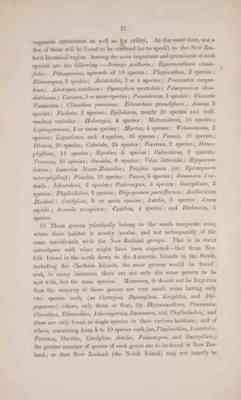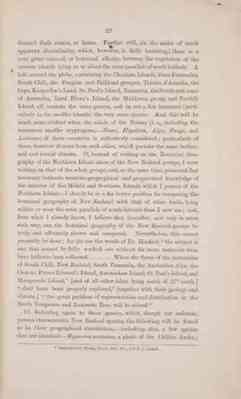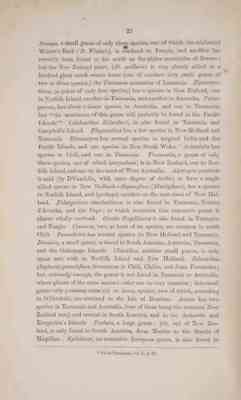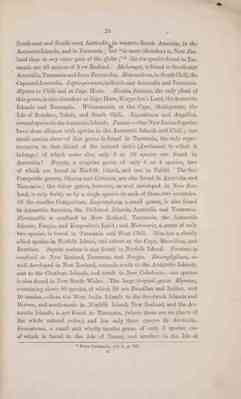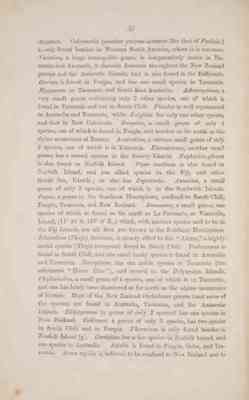Pages
21 vegetable appearance as well as for utility. At the same time, not a few of those will be found to be confined (so to speak) to the New Zealand Botanical region. Among the more important and prominent of such species are the following:- Drimys axillaris; Hymenanthera crassifolia; Pittosporum, upwards of 10 species; Plagianthus, 2 species; Elaeocarpus, 2 species; Aristotelia, 3 or 4 species; Pennantia corymbosa; Alectryon excelsum; Dysoxylum spectabile; Pelargonium clandestinum; Coriara, 3 or more species; Pomaderris, 3 species; Discaria Toumatou; Clianthus puniceus; Edwardsia grandiflora; Acaena 3 species; Fuchsia, 2 species; Epilobium, nearly 20 species and wellmarked varieties; Haloragis, 4 species; Metrosideros, 10 species; Leptospermum, 2 or more species; Myrtus, 4 species; Weinmannia, 2 species; Ligusticum and Angelica, 16 species; Panax, 10 species; Olearia, 20 species; Celmisia, 24 species, Forstera, 2 species; Dracophyllum, 14 species, Myrsine, 5 species; Calceolaria, 2 species; Veronica, 40 species; Ourisia, 6 species; Vitex littoralis; Myoporum Laetum; Laurelia Novae-Zelandiae; Trophis opaca (or, Epicarpurus microphyllus); Pimelea, 10 species; Fagus, 5 species; Dammara Australis; Libocedrus, 2 species; Podocarpus, 5 species, Daerydium, 3 species; Phyllocladus, 2 species; Rhipogonum parviflorum; Anthericum Hookeri; Cordyline, 5 or more species; Astelia, 5 species; Areca sapida; Arundo conspicua; Cyathea, 4 species; and Dicksonia, 3 species.
18. Those genera principally belong to the south temperate zone, where their habitat is mostly insular, and not unfrequently of the same meridionals with the New Zealand groupe. This is in strict accordance with what might have been expected - that from Norfolk Island in the north down to Antarctic Islands in the South, including the Chatham Islands, the same genera would be found; and, in many instances, there are not only the same genera to be met with, but the same species. Moreover, it should not be forgotten that the majority of those genera are very small, some having only two species each, (as Alectryon, Dysoxylum, Knightia, and Rhipogonum) others, only three or four, (as Hymenanthera, Pennantia, Clianthus, Edwardsia, Atherosperma, Dammara, and Phyllocladus,) and these are only found as single species in their various habitats; and of others, containing from 5 to 10 species each, (as, Plagianthus, Aristotelia, Forstera, Ourisia, Cordyline, Astelia, Podocarpus, and Dacrydium,) the greater numer of species of each genus are to found in New Zealand; so that New Zealand (the North Island) may not inaptly be
22 deemed their centre, or home. Further still, (in the midst of much apparent dissimilarity, which, however, is daily lessening,) there is a very great concord, or botanical affinity, between the vegetation of the various islands lying in or about the same parallels of south latitude. A belt around the globe, containing the Chatham Islands, Juan Fernandez, South Chili, the Fuegian and Falkland groupes, Tristan d'Acunha, the Cape, Kerguelen's Land, St Paul's Island, Tasmania, the South east coast of Australia, Lord Howe's Island, the Middleton group, and Norfolk Island, all contain the same genera, and in not a few instances (particularly in the smaller islands) the very same species. And this will be much more evident when the whole of the Botany (i.e., including the numerous smaller cryptogams, - Musci, Hepaticae, Algae, Fungi, and Lichenes) of those countries is collectively considered; particularly of those, however distant from each other, which partake the same isothermal and humid climate. If, instead of writing on the Botanical Geography of the Northern Island alone of the New Zealand groupe, I were writing on that of the whole groupe, and, at the same time, possessed that necessary intimate botanico-geographical and geognostical knowledge of the interior of the Middle and Southern Islands which I possess of the Northern Island - I should be in a far better position for comparing the botanical geography of New Zealand with that of other lands, lying within or near the same parallels of south latitude than I now am; and, from what I already know, I believe that hereafter, and only in some such way, can the botanical geography of the New Zealand groupe be truly and efficiently shown and compared. Nevertheless, this cannot presently be done; for (to use the words of Dr Hooker) "the subject is one that cannot be fully worked out without far more materials than have hitherto been collected........... When the floras of the mountains of South Chili, New Zealand, South Tasmania, the Australia Alps, the Crozats, Prince Edward's Island, Amsterdam Island, St Paul's Island, and Macquarrie Island," [and of all other islets lying south of 27o south.] "shall have been properly explored," [together with their geology and climate,] "the great problem of representation and distribution in the South Temperate and Antarctic Zone will be solved.*
19. Referring again to those genera, which, though not endemic possess characteristic New Zealand species, the following will be found to be their geographical distribution, - including, also, a few species that are identical - Myosurus aristatus, a plant of the Chilian Andes; _____________________________________________________________ * Introductory Essay, Flora Nov. Zel., vol. L., p. xxxiii.
23 Drimys, a small genus of only three species, one of which, the celebrated Winter's Bark (D. Winteri), is confined to Fuegia, and another has recently been found so far north as the alpine mountains of Borneo; but the New Zealand plant, (D. axillaris) is very closely allied to a kindred plant much nearer home (one of another very small genus of two or three species,) the Tasmania aromatica of Tasmania. Hymenanthera, ( a genus of only four species,) has a species in New Zealand, one in Norfolk Island, another in Tasmania, and another in Australia. Pittosporum, has about a dozen species in Australia, and one in Tasmania, but "the maximum of this genus will probably be found in the Pacific Islands."* Colobanthus Billardieri, is also found in Tasmania and Campbell's Island. Plagianthus has a few species in New Holland and Tasmania. Elaeocarpus has several species in tropical India and the Pacific Islands, and one species in New South Wales. Aristotelia has species in Chili, and one in Tasmania. Pennantia, a genus of only three species, one of which (corymbosa) is in New Zealand, one in Norfolk Island, and one on the coast of West Australia. Alectryon excelsum is said (by D'Candolle, with some degree of doubt) to have a single allied species in New Holland - Dysoxylum (Hartighsea), has a species in Norfolk Island, and (perhaps) another on the east coast of New Holland. Pelargonium clandestinum is also found in Tasmania, Tristan d'Acunha, and the Cape; to which countries this extensive genus is almost whollly confined. Oxalis Magellanica is also found in Tasmania and Fuegia. Coriaria, two, at least of its species, are common in south Chili. Pomaderris has several species in New Holland and Tasmania. Discaria, a small genus, is found in South America, Australia, Tasmania, and the Gallapago Islands. Clianthus, another small genus, is only again met with in Norfolk Island and New Holland. Edwardsia (Sophora) grandiflora, is common in Chili, Chiloe, and Juan Ferandez; but curiously enough the genus is not found in Tasmania or Australia, where plants of the same natural order are so very common; this small genus only possesses some six or seven species, two of which, according to D'Candolle, are confined to the Isle of Bourbon. Acaena has two species in Tasmania and Australia, (one of them being the common New Zealand one,) and several in South America, and in the Antarctic and Kerguelen's Island. Fuchsia, a large genus; yet, out of New Zealand, is only found in South America, from Mexico to the Straits of Magellan. Epilobium, an extensive European genus, is also found in ___________________________________________________________ * Flora Tasmania, vol. I., p. 38.
254 South-east and South-west Australia, in western South America, in the Antarctic Islands, and in Tasmania; but "is more abundant in New Zealland than in any other part of the globe;"* the six species found in Tasmania are all natives of New Zealand. Haloragis, is found in South-east Australia, Tasmania and Juan Fernandez. Metrosideros, in South Chili, the Cape and Australia. Leptospermum, in South-east Australia and Tasmania. Myrtus in Chili and at Cape Horn. Montia fontana, the only plant of this genus, is also abundant at Cape Horn, Kerguelen's Land, the Antarctic Islands and Tasmania. Weinmannia, at the Cape, Madagascar, the Isle of Bourbon, Tahiti, and South Chili. Ligusticum and Angelica, several species in the Antarctic Islands. Panax - Our New Zealand species have close alliance with species in the Antarctic Islands and Chili; one small species alone of this genus is found in Tasmania, the only representative in that island of the natural order (Araliaceae) to which it belongs! of which order also, only 8 or 10 species are found in Australia! Meryta, a singular genus of only 4 or 5 species, two of which are found in Norfolk Island, and one in Tahiti. The fine Composite genera, Olearia and Celmisia, are also found in Australia and Tasmania; the latter genus, however, so well developed in New Zealand, is only feebly so by a single species in each of those two countries. Of the smaller Compositeae, Lagenophora, a small genus, is also found in Antartic America, the Falkland Islands, Australia and Tasmania. Abrotanella is confined to New Zealand, Tasmania, the Antarctic Islands, Fuegia, and Kerguelen's Land; and Microseris, a genus of only two species, is found in Tasmania and West Chili. Olea has a closely allied species in Norfolk Island, and others at the Cape, Mauritius, and Bourbon. Sapota costata is also found in Norfolk Island. Forstera is confined to New Zealand, Tasmania, and Fuegia. Dracophyllum, so well developed in New Zealand, extends south to the Antarctic Islands, east to the Chatham Islands, and north to New Caledonia; one species is also found in New South Wales. The large tropica genus Myrsine, containing above 80 species, of which 50 are Brazilian and Indian, and 30 insular, -from the West India Islands to the Sandwich Islands and Borneo, and southwards in Norfolk Islands, New Zealand, and the Antarctic Islands, is not found in Tasmania, (where there are no plants of the whole natural order,) and has only three species in Australia. Geniostoma, a small and wholly insular genus of only 3 species, one of which is found in the Isle of Tanna, and another in the Isle of ______________________________________________________________ *Flora Tasmaniae, vol. i., p. 116. E
25 Bourbon. Calceolaria (another curious instance like that of Fuchsia,) is only found besides in Western South America, where it is common. Veronica, a large cosmopolite genus, is comparatively scarce in Tasmania and Australia, it abounds however throughout the New Zealand groupe and the Antartctic Islands, and is also found in the Falklands. Ourisia is found in Fuegia, and has one small species in Tasmania. Myoporum in Tasmania and South East Australia. Atherosperma, a very small genus containing only 3 other species, one of which is found in Tasmania and one in South Chili. Pimelea is well represented in Australia and Tasmania, while Knightia has only one other species, and that in New Caledonia. Drapetes, a small genus of only 4 species, one of which is found Fuegia, and another as far north as the alpine mountains of Borneo. Australina, a curious small genus of only 2 species, one of which is in Tasmania. Elatostemma, another small genus, has a second species in the Society Islands. Euphorbia glauca is also found in Norfolk Island. Piper excelsum is also found in Norfolk Island, and has allied species in the Fiji, and other South Sea, Islands; so also has Peperomia. Ascarina, a small genus of only 2 species one of which is in the Sandwich Islands. Fagus, a genus in the Southern Hemisphere, confined to South Chili, Fuegia, Tasmania, and New Zealand. Dammara, a small genus, one species of which is found so far north as La Perouse's, or Vanicolla, Island, (11o40' S. 167o0' E.,) which, with another species said to be in the Fiji Islands, are all that are known in the Southern Hemisphere. Libocedrus (Thuja) Doniana, is closely allied to the "Alerse," a highly useful species (Thuja tetragona) found in South Chili. Podocarpus is found in South Chili, and one small bushy species is found in Australia and Tasmania. Dacrydium has one noble species in Tasmania (the celebrated "Huon Pine"), and several in the Polynesian Islands. Phyllocladus, a small genus of 4 species, one of which is in Tasmania, and one has lately been discovered so far north as the alpine mountains of Borneo. Most of the New Zealand Orchideous genera (and some of the species) are found in Australia, Tasmania, and the Antarctic Islands. Rhipogonum (a genus of only 2 species) and one species in New Holland. Callixene, a genus of only 3 species, has two species in South Chili and Fuegia. Phormium is only found besides in Norfolk Island (g). Cordyline has a few species in Norfolk Island, and one species in Australia. Astelia is found in Fuegia, Oahu, and Tasmania. Areva sapida is believed to be confined to New Zealand and to
